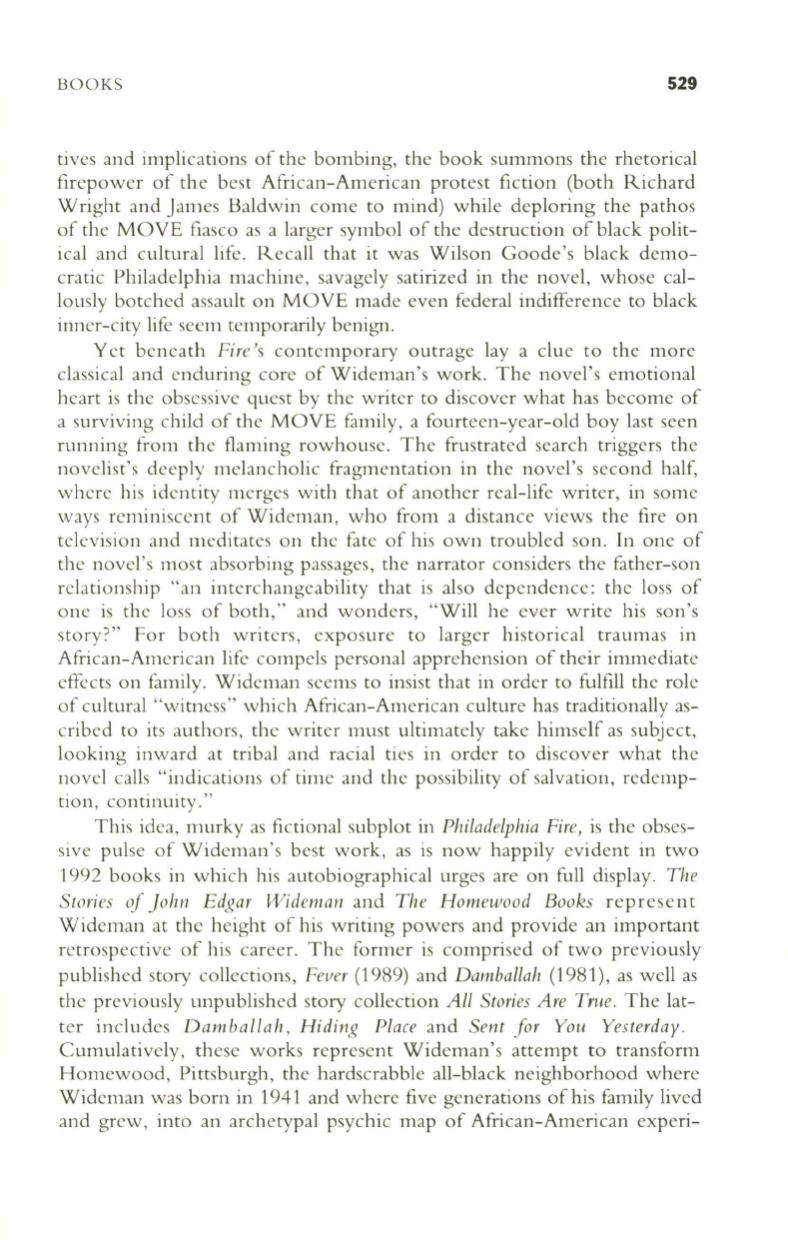
BOOKS
529
tives and implications of the bombing, the book summons the rhetorical
firepower of the best African-American protest fiction (both Richard
Wright and James Baldwin come to mind) while deploring the pathos
of the MOVE fiasco as a larger symbol of the destruction of black polit–
ical and cultural life . Recall that it was Wilson Goode's black demo–
cratic Philadelphia machine, savagely satirized in the novel, whose cal–
lously botched assault on MOVE made even federal indifference to black
inner-city life seem temporarily benign.
Yet beneath
Fire's
contemporary outrage lay a clue to the more
classical and enduring core of Wideman's work. The novel's emotional
heart is the obsessive quest by the writer to discover what has become of
a surviving child of the MOVE family, a fourteen-year-old boy last seen
running from the flaming rowhouse. The frustrated search triggers the
novelist's deeply melancholic fragmentation in the novel's second half,
where his identity merges with that of another real-life writer, in some
ways reminiscent of Wideman, who from a distance views the fire on
television and meditates on the fate of his own troubled son. In one of
the novel's most absorbing passages, the narrator considers the father-son
relationship "an interchangeability that is also dependence: the loss of
one is the loss of both," and wonders, "Will he ever write his son's
story?" For both writers, exposure to larger historical traumas in
African-American life compels personal apprehension of their immediate
effects on family. Wideman seems to insist that in order to fulfill the role
of cultural "witness" which African-American culture has traditionally as–
cribed to its authors, the writer must ultimately take himself as subject,
looking inward at tribal and racial ties in order to discover what the
novel calls "indications of time and the possibility of salvation, redemp–
tion, continuity."
This idea, murky as fictional subplot in
Philadelphia Fire,
is the obses–
sive pulse of Wideman's best work, as is now happily evident in two
1992 books in which his autobiographical urges are on full display.
The
Stories of John Edgar Wideman
and
The Homewood Books
represent
Wideman at the height of his writing powers and provide an important
retrospective of his career. The former is comprised of two previously
published story collections,
Fever
(1989) and
Damballah
(1981), as well as
the previously unpublished story collection
All Stories Are True.
The lat–
ter includes
Damballah, Hiding Place
and
Sent for You Yesterday.
Cumulatively, these works represent Wideman's attempt to transform
Homewood, Pittsburgh, the hardscrabble all-black neighborhood where
Wideman was born in 1941 and where five generations of his family lived
and grew, into an archetypal psychic map of African-American experi-


